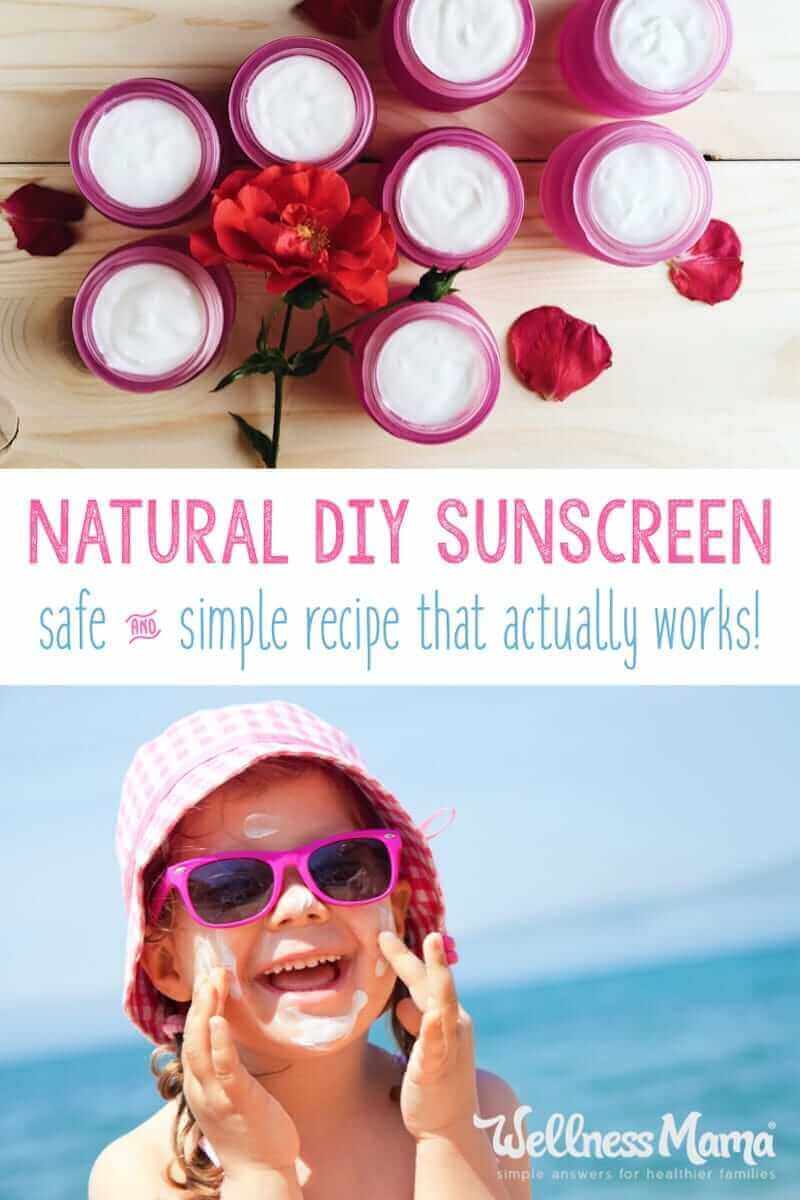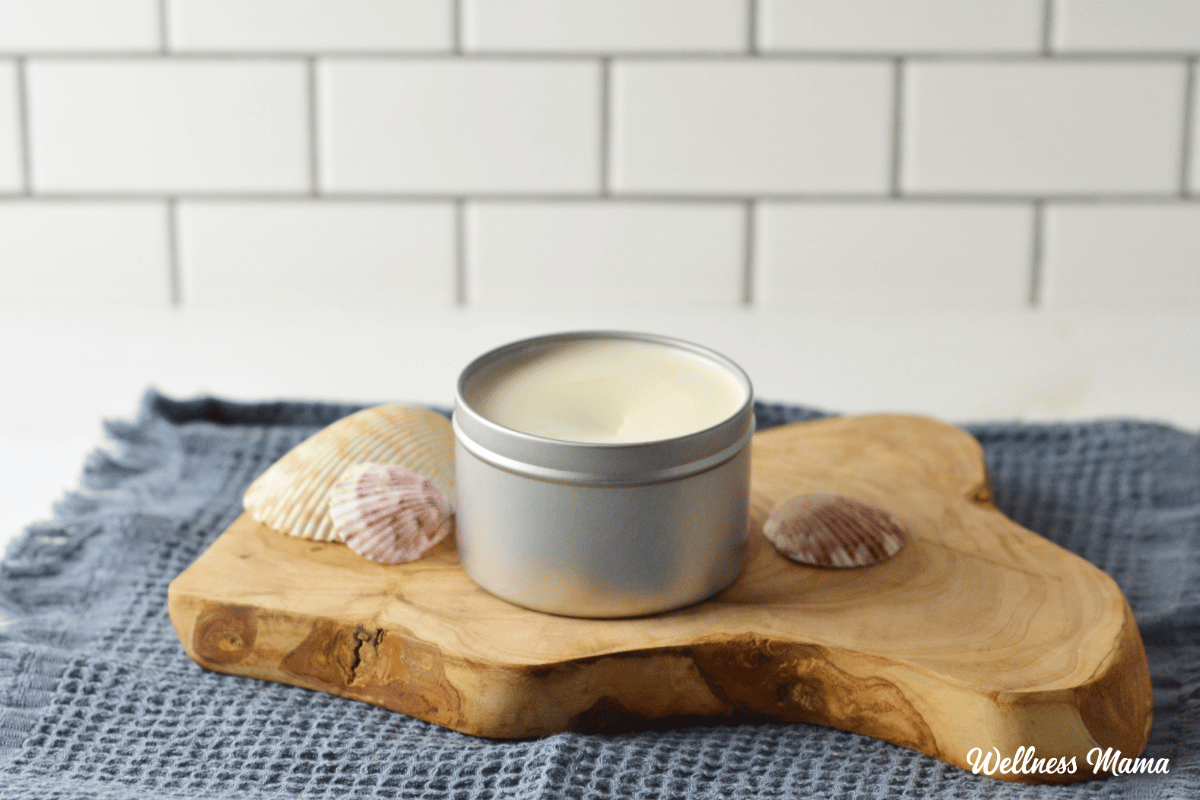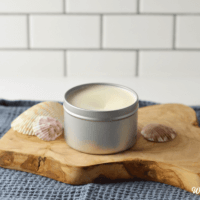In the book Zero to One, Peter Thiel asks readers to consider what views/truths they believe that very few people agree with them on. For me, it’s that most sunscreen does not help avoid skin cancer and may actually increase the chances of it! This is one of the reasons I’ve been making homemade sunscreen for years (even though I rarely use it).
Sound crazy?
Sunburn is harmful… we all agree on that and it should absolutely be avoided. But sunscreen isn’t the only way to avoid it.
It’s definitely not a popular opinion, and I’m certainly not encouraging you to avoid wearing sunscreen or to ignore the advice of your doctor. I am, however, encouraging you to do your own research, look at the actual studies, and use common sense when it comes to sun exposure.
Why Make Homemade Sunscreen?
I explain in full my stance on sunscreen here, but here’s why I decided to try making my own years ago.
Avoid Hormone-Disrupting Chemicals
In the years since sunscreen use began, skin cancer rates have risen. Many reports show that most commercial sunscreens actually raise skin cancer risk. This might be due in part to the fact that many sunscreens contain endocrine-disrupting chemicals such as oxybenzone. Oxybenzone is a known hormone disruptor that isn’t recommended for use on children. It’s been banned in many locations worldwide.
A 2020 study looked at several different active ingredients in sunscreen products. While they did offer SPF protection, chemicals like avobenzone are absorbed into the bloodstream, even after one use.
My DIY sunscreen recipe relies on a physical mineral barrier that stays on the skin’s surface. It doesn’t penetrate through as most synthetic chemical sunscreens do.
There are many more mineral sunscreens with safer ingredients on the market now than when I first started making homemade sunscreen. I’ve listed some of my favorite EWG-rated sunscreens below. That being said, you still have to read labels. Even more “natural” sunscreens can still contain problematic ingredients.
Protect the Coral Reefs
Recent research shows the ingredients in many sunscreens harm ocean life, especially coral. Researchers estimate over 5,000 metric tons of sunblock wash off of swimmers each year. This “swimmer pollution” threatens a large part of the coral life in the ocean and many other ocean species as well. This is because these compounds may awaken dormant viruses in symbiotic algae called zooxanthellae, which provide food and color to the coral.
Some sunscreen ingredients have even been banned in some places due to their negative environmental effects on the coral reefs. This natural sunscreen recipe avoids all such ingredients.
The Vitamin D Factor
Also, our bodies need some exposure to the sun to make vitamin D, a necessary building block for hormone function. Combine vitamin D deficiency with hormone-disrupting sunscreen ingredients like oxybenzone and is it any wonder some of us are concerned?
I don’t buy the idea that even moderate sun exposure is harmful when our bodies need vitamin D and light exposure for so many aspects of health. Getting some of the sun’s rays every day is an important part of my daily routine. I also take astaxanthin daily to help protect my skin from the inside out (read why here).
Looking at these reasons, it makes sense to ask if sunscreen is the best or only way to avoid sunburn.
Is Homemade Sunscreen Dangerous?
Several recent articles claim that homemade sunscreens are harmful and you should never make your own sunscreen. This is because the FDA tightly regulates and verifies the SPF protection of commercial sunscreens. Since you can’t verify the SPF of homemade sunscreens, the chance of burning is higher.
I certainly agree that homemade sunscreens don’t have the lab testing that conventional ones do. But you know what else they don’t have? Endocrine disruptors and coral-killing compounds. Also, sunscreen should be a last resort as shade and getting out of the sun’s UV rays in the heat of the day are better options anyway.
So while maybe we shouldn’t use homemade sunscreens like conventional ones, I’d also argue we shouldn’t use conventional sunscreens in the way we do either!
Bottom Line: Use common sense and get safe sun exposure. The amount and safety will vary by person. I recommend doing your own research and talking to a knowledgeable naturopath or dermatologist to figure out what works best for you.
A Common Sense Approach to Sun
In most cases, my approach is to get adequate but moderate daily sun exposure, without getting close to burning. Since most of us don’t work outside these days, it takes effort to get daily sun, rather than to avoid it. I definitely don’t slather on the coral-destroying sunscreen on the off chance I might encounter a few stray rays of sunlight, and in fact, I welcome it!
Thanks to Nutrition Genome Testing, I know that I have mutations that make it very difficult to get enough vitamin D. This puts me at risk for a lot of serious diseases, and supplements don’t work very well to raise my levels. For this reason, my doctor advised me to get adequate vitamin D… from natural sun exposure.
Of course, there’s a limit to how much sun a person needs or should get. Here’s what I do when I reach this limit:
Use the Shade or Cover Up
If I’m going to be out in the sun for much longer than my skin is used to, it’s easy enough to put on a hat or shirt to shield my skin. This is the approach that the Environmental Working Group (EWG) recommends. It’s more effective at stopping excess sun exposure, costs less, and doesn’t harm the environment. A common sense win/win scenario.
Use Natural Sunscreen When Needed
If I’m going to be in intense sun and can’t easily cover up, I will very occasionally use a natural sunscreen. I’ve yet to use it this year and hope not to at all, but I’m sharing my recipe (and the healthiest options for store-bought sunscreens).
Important Note: Unlike most sunscreens, natural and homemade sunscreens may not be as waterproof or have as high (or broad spectrum) SPF. Homemade versions may not protect as fully against UVA and UVB rays. I am not recommending entirely avoiding sunscreen or getting too much sun which could lead to sunburn or sun damage.
Support Skin From the Inside Out
Sun exposure itself isn’t the only factor linked to skin cancer. Many nutritional factors, such as optimal vitamin D levels or even reducing harmful omega-6 vegetable oils, can have a big impact on skin health. Getting enough antioxidants in our diet from colorful fruits and veggies also plays a big role. See this post for how I optimize my diet and supplements for healthy skin and improved sun tolerance.
Natural Sunscreen SPF
This homemade sunscreen uses a blend of waxes, butter, and oils to make a moisturizing base. The main ingredient for natural SPF (sun protection factor) though is zinc oxide. It acts as a barrier on the skin to block harmful UV rays. Non-nano and uncoated zinc oxide is the healthiest option for skincare.
My homemade sunscreen also uses skin-nourishing and moisturizing antioxidant ingredients for even more skin protection. These include red raspberry seed oil, carrot seed oil, and vitamin E.
The final version will have a varied sun protective ability depending on the amount of each ingredient used. This recipe uses about 10% zinc oxide which is roughly a 6-11 SPF. If you want an SPF of around 20, then double the zinc oxide. Keep in mind it hasn’t been tested by a regulatory organization for exact SPF.
For a simple version, even just coconut oil and shea butter with some zinc oxide or a little raspberry seed and carrot seed oil will work for moderate exposure.
As always check with your doctor or dermatologist before using any new products.
NOTE: This is an improved recipe since many people were having trouble getting the temperatures exactly right to get the lotion to emulsify (as per the comments below). This recipe shouldn’t have any of those issues!
Optional Essential Oils
You can add some skin-safe essential oils here for added benefits and scent. Be sure to avoid any phototoxic oils, as these can cause serious skin burns if used before sun exposure. Common phototoxic oils include:
- bergamot
- bitter orange (wild or sweet orange are fine)
- cold-pressed lemon (steam-distilled is ok)
- cold-pressed lime oil (steam-distilled is ok)
- grapefruit (experts are mixed on this one)
Do not use the above essential oils for sunscreen! Some better options include lavender, frankincense, sweet orange, or sandalwood.
Homemade Sunscreen Recipe
Equipment
- Pint size mason jar with lid (or a double boiler)
Materials
- ½ cup sweet almond oil (or avocado oil or olive oil)
- ¼ cup coconut oil
- ¼ cup beeswax pellets
- 2 TBSP non-nano zinc oxide powder
- 1 tsp red raspberry seed oil (or less, optional)
- 1 tsp carrot seed oil (or less, optional)
- 2 TBSP shea butter (optional)
- 25 drops essential oils (not phototoxic ones)
- ¼ tsp vanilla extract (optional, for scent)
- ½ tsp vitamin E oil (optional, to extend shelf life)
Instructions
- Combine all the ingredients except zinc oxide in a pint-sized or larger glass jar. You can also use a double boiler instead of a jar.
- Fill a medium saucepan with a few inches of water and place on the stove over medium heat.
- Put a lid loosely on the jar and place it in the pan with the water.
- Stir occasionally to mix the ingredients as they melt.
- When all the ingredients are completely melted, stir in the zinc oxide. This will take some stirring to incorporate.
- Pour into whatever jar or tin you’ll use for storage.
- Stir a few times as it cools to make sure the zinc oxide is incorporated.
- Store at room temperature or in the refrigerator to increase shelf life.
Notes
- This sunscreen is not waterproof and will need to be reapplied after sweating or swimming.
- Make sure not to inhale the zinc oxide. Use a mask if necessary!
- Add more beeswax to make thicker sunscreen, less to make smooth sunscreen.
- Store in a cool, dry place or in the fridge. I prefer to store it in a small canning jar and apply it like body butter. It will be thicker, especially if you use coconut oil in the recipe.
- Remove the zinc oxide and this makes an excellent lotion recipe!
An Even Faster Way to Make Sunscreen
This easy recipe just takes two ingredients. While there’s no exact SPF guarantee, it should yield about 20 SPF.
- 1/2 cup of your favorite lotion (that doesn’t have phototoxic oils!)
- 2 Tablespoons of non-nano zinc oxide
- Mix well
You can also make sunscreen bars with many of the same ingredients!
Store-Bought Natural Sunscreens
Not Interested in DIY? I’ve gotten numerous questions over the years about pre-made sunscreen options for those who don’t have the time or desire to make their own. I list my favorite store-bought brands in this post.
Does your family regularly use sunscreen? Do you try to get regular sun exposure? Leave a comment and let us know!
This article was medically reviewed by Dr. Scott Soerries, MD, Family Physician and Medical Director of SteadyMD. As always, this is not personal medical advice and we recommend that you talk with your doctor.




Leave a Reply